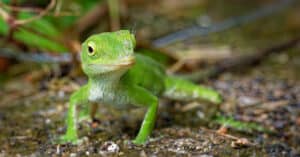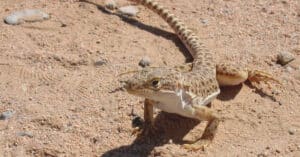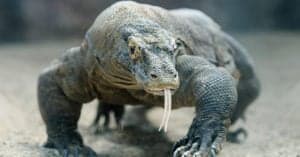Leopard Gecko Tank Setup Ideas
Having a properly set up enclosure for your leopard gecko is crucial to both their health and overall happiness under your care. From correct lighting to temperature to humidity and decorations, creating a leopard gecko habitat can be a confusing process, especially for novice reptile keepers. If you’re struggling with how to set up your leopard gecko’s habitat, check out our guide to leopard gecko tank setup ideas here!
We’ll cover everything you need to know about perfecting your new reptile friend’s home. In addition, we’ve added five great tips to elevate your gecko’s tank setup from basic to something truly extraordinary!
Setting Up A Leopard Gecko Tank: The Basics
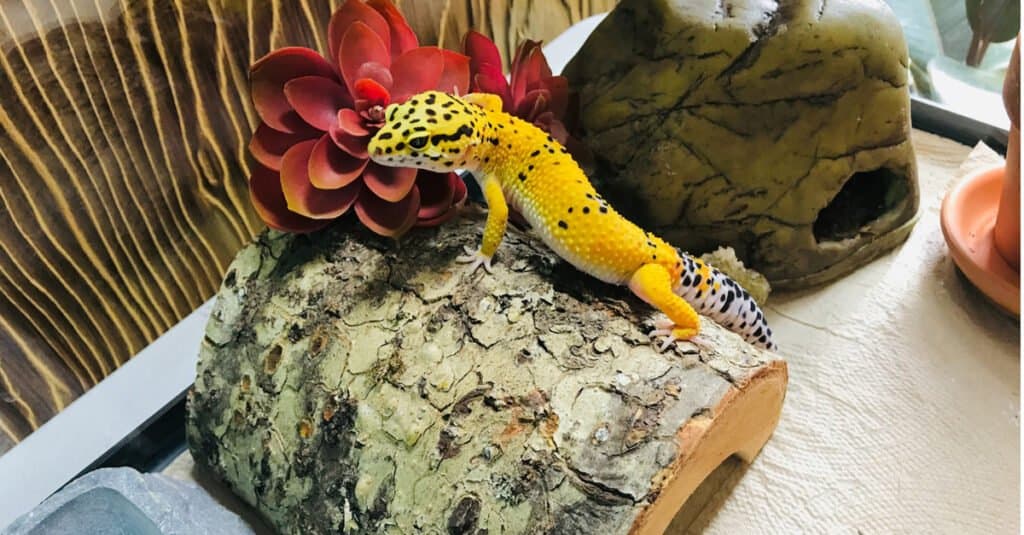
Madison Stuczynski/Shutterstock.com
Before you get to playing with elaborate setups and decorations, it’s best to first thoroughly understand the basics your leopard gecko’s tank will need. Although leopard geckos are low-maintenance pets, they still have many unique care requirements that must be met for them to truly thrive in captivity.
The main things you’ll need to supply your gecko’s tank with are:
- Adequate heating. The enclosure needs gentle gradient from the hot side (the basking area) to the cooler side. Under the basking area, temperatures should be between 85 to 90F, while the cooler end should be between 75 to 80F. The temperatures in between the cold and hot sides should range from around 80 to 85F.
- Lighting and a 12/12 photocycle. Enclosure lighting should mimic natural sunlight: 12 hours on, 12 hours off. This can easily be achieved with a simple white basking bulb (which will also provide heat to your gecko’s habitat).
- Proper humidity. Since leopard geckos are desert dwellers, they need low humidity settings in captivity, or around 30% to 40% at all times. Keep moisture to a minimum. Place your gecko’s water dish away from the basking bulb to prevent evaporation (which adds more moisture to the air).
- Dry and humid hides. A hide is simply a small, covered shelter for your gecko to sleep in or find privacy if they’re feeling shy. The humid hide should be placed towards the middle of the enclosure, filled with damp substrate, and misted daily. The dry hide should be towards the cooler end of the enclosure and have dry substrate.
- Safe substrate. Substrate makes up the floor of your gecko’s enclosure. Avoid “loose,” substrates, or those made up of small, indigestible particles. Sand, gravel, and wood chips, for example, are unsafe substrates, as your gecko could accidentally ingest them and become impacted. The safest options are tile, flat stones, reptile carpet, or paper towels.
- Food and water dishes. Keep these as clean as possible. Place the water dish towards the cooler end of the enclosure to prevent the water from evaporating and raising the tank’s humidity. Keep substrate out of your gecko’s food and water dish, especially during meal times.
- Decorations. From plants to bridges and signs and other fun decorations, your gecko’s tank will need some clutter to make your pet feel sheltered and safe.
Now that you have a better idea of the basics your scaly friend’s habitat needs, let’s get into some fun leopard gecko tank setup ideas. These tips will elevate your pet’s tank from basic to beautiful in just a few simple and inexpensive steps!
Tank Setup Ideas: Experiment with Hides
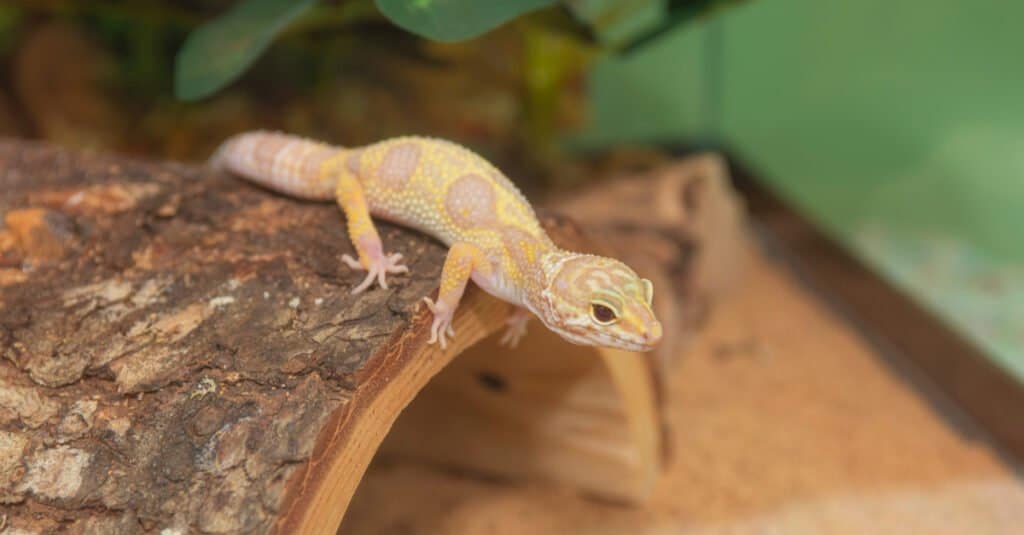
LHolmes Photography/Shutterstock.com
As we briefly covered above, your gecko’s enclosure needs two hides: a dry hide and a humid hide. Thankfully, you have a lot of room for experimentation here as far as size, shape, and style go. Both of your gecko’s hides should be small enough to be cozy yet large enough to comfortably fit the lizard’s entire body. Aside from that, though, you can choose whatever hides look great to you or even make your own!
Some examples of hides on the market are hollowed-out coconuts, wooden logs, stone caves, or even those with built-in humidifiers if you don’t feel like misting your gecko’s humid hide every single day.
Tank Setup Ideas: Plants, Plants, Plants!

Vladislav_Bagnyuk/Shutterstock.com
Leopard geckos are terrestrial and don’t climb much naturally. However, they do still benefit from a generous amount of plant cover in their enclosures in captivity. It doesn’t really matter if the plants are real or artificial. Be warned, however, that genuine plants can raise the humidity to unsafe levels.
Another good reason to use artificial plants instead of actual plants is they last longer and are easier to set up, care for, and move, especially for novice reptile owners. Your gecko also has no risk of eating them, since leopard geckos are strictly insectivorous.
The best part is you can get pretty creative with them! Try using plants of different shapes and sizes (hanging vines, large, sturdy plants with lots of leaves, etc.) to give your gecko a bit more privacy. Plants also provide enrichment and encourage your gecko to explore and interact with their environment.
Tank Setup Ideas: Customize the Background

Vladislav_Bagnyuk/Shutterstock.com
Most basic enclosures have transparent glass or mesh walls, which can be a bit boring for you and your gecko to look at. Being able to see out of their enclosure can also make your leo feel exposed or stressed, which is why lots of decor and plant cover is beneficial for them.
There’s a lot you can do when it comes to customizing the background in your gecko’s enclosure! Many brands and online retailers even sell premade backgrounds of desert landscapes that mimic your gecko’s natural habitat. Simply unroll the sheet, cut it to size, and either glue or tape it to the back of the enclosure!
Tank Setup Ideas: Experiment with Substrates
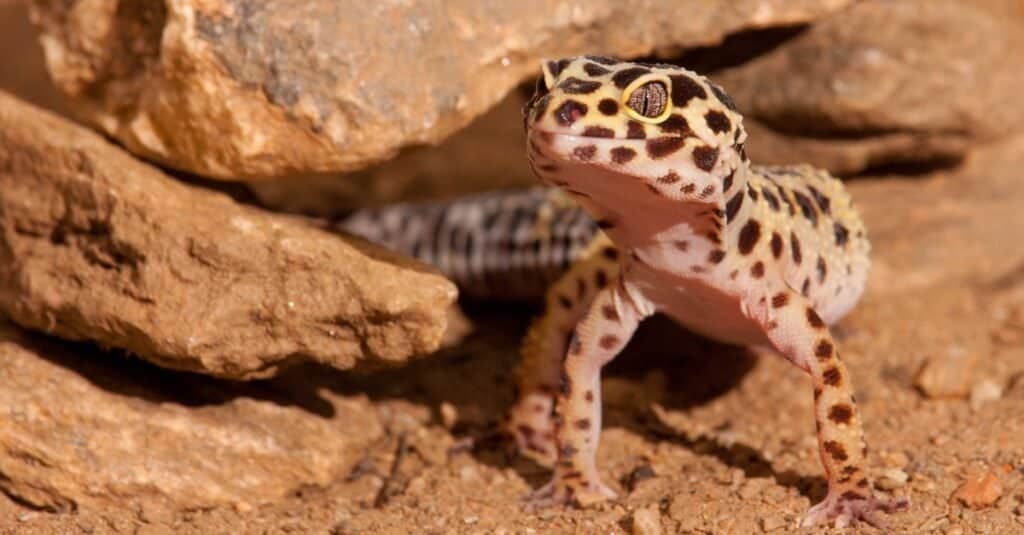
iStock.com/Daniel Castillo
Substrates can also spruce up a reptile enclosure in a pinch, especially if you’re on a budget. Of course, using a safe substrate is crucial here. Many loose substrates contain small, indigestible particles. These substrates, such as sand, gravel, and wood chips, pose a risk of impaction.
Thankfully, there are just as many safe substrates that look great and feel great for your gecko to walk on, such as:
- Flat stones or tiles
- Stick-down linoleum
- Reptile carpet
- Reptile sand mats
- Bioactive substrates (not recommended for novice reptile keepers)
Try experimenting with these different substrates to find what looks best to you! Sand mats are especially natural-looking, and they are much safer than actual sand since the sand particles and pebbles are secured safely to the mat.
Tank Setup Ideas: Experiment with Elevation Variation
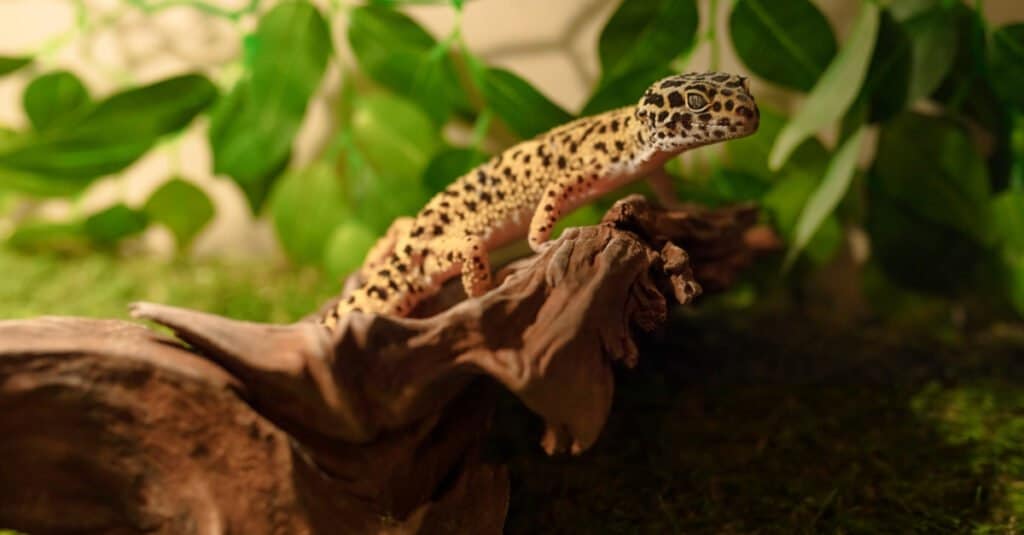
Elena Belodedova/Shutterstock.com
If your leopard gecko’s enclosure doesn’t have much elevation to speak of, why not give it a bit more dimension? Although leopard geckos don’t climb as much as most other lizards, they do appreciate enclosures that aren’t completely flat. We love this one as far as leopard gecko tank setup ideas go because there’s so much room for customization!
Remember, you ideally want to mimic your pet’s natural habitat as closely as possible (within reason, of course). In the wild, leopard geckos live in hilly, sandy deserts and scrublands, which have lots of variation in their elevation and terrain. Try stacking flat stones, adding bridges, hammocks, or other platforms, or even small inclines here and there!
Not only will your gecko’s enclosure look better as a result, but your gecko will also enjoy the extra enrichment of exploring a more interesting-looking, authentic habitat.
More from A-Z Animals
Having a properly set up enclosure for your leopard gecko is crucial to both their health and overall happiness under your care. From correct lighting to temperature to humidity and decorations, creating a leopard gecko habitat can be a confusing process, especially for novice reptile keepers. If you’re struggling with how to set up your leopard gecko’s habitat, check out our guide to leopard gecko tank setup ideas here!
We’ll cover everything you need to know about perfecting your new reptile friend’s home. In addition, we’ve added five great tips to elevate your gecko’s tank setup from basic to something truly extraordinary!
Setting Up A Leopard Gecko Tank: The Basics

Madison Stuczynski/Shutterstock.com
Before you get to playing with elaborate setups and decorations, it’s best to first thoroughly understand the basics your leopard gecko’s tank will need. Although leopard geckos are low-maintenance pets, they still have many unique care requirements that must be met for them to truly thrive in captivity.
The main things you’ll need to supply your gecko’s tank with are:
- Adequate heating. The enclosure needs gentle gradient from the hot side (the basking area) to the cooler side. Under the basking area, temperatures should be between 85 to 90F, while the cooler end should be between 75 to 80F. The temperatures in between the cold and hot sides should range from around 80 to 85F.
- Lighting and a 12/12 photocycle. Enclosure lighting should mimic natural sunlight: 12 hours on, 12 hours off. This can easily be achieved with a simple white basking bulb (which will also provide heat to your gecko’s habitat).
- Proper humidity. Since leopard geckos are desert dwellers, they need low humidity settings in captivity, or around 30% to 40% at all times. Keep moisture to a minimum. Place your gecko’s water dish away from the basking bulb to prevent evaporation (which adds more moisture to the air).
- Dry and humid hides. A hide is simply a small, covered shelter for your gecko to sleep in or find privacy if they’re feeling shy. The humid hide should be placed towards the middle of the enclosure, filled with damp substrate, and misted daily. The dry hide should be towards the cooler end of the enclosure and have dry substrate.
- Safe substrate. Substrate makes up the floor of your gecko’s enclosure. Avoid “loose,” substrates, or those made up of small, indigestible particles. Sand, gravel, and wood chips, for example, are unsafe substrates, as your gecko could accidentally ingest them and become impacted. The safest options are tile, flat stones, reptile carpet, or paper towels.
- Food and water dishes. Keep these as clean as possible. Place the water dish towards the cooler end of the enclosure to prevent the water from evaporating and raising the tank’s humidity. Keep substrate out of your gecko’s food and water dish, especially during meal times.
- Decorations. From plants to bridges and signs and other fun decorations, your gecko’s tank will need some clutter to make your pet feel sheltered and safe.
Now that you have a better idea of the basics your scaly friend’s habitat needs, let’s get into some fun leopard gecko tank setup ideas. These tips will elevate your pet’s tank from basic to beautiful in just a few simple and inexpensive steps!
Tank Setup Ideas: Experiment with Hides

LHolmes Photography/Shutterstock.com
As we briefly covered above, your gecko’s enclosure needs two hides: a dry hide and a humid hide. Thankfully, you have a lot of room for experimentation here as far as size, shape, and style go. Both of your gecko’s hides should be small enough to be cozy yet large enough to comfortably fit the lizard’s entire body. Aside from that, though, you can choose whatever hides look great to you or even make your own!
Some examples of hides on the market are hollowed-out coconuts, wooden logs, stone caves, or even those with built-in humidifiers if you don’t feel like misting your gecko’s humid hide every single day.
Tank Setup Ideas: Plants, Plants, Plants!

Vladislav_Bagnyuk/Shutterstock.com
Leopard geckos are terrestrial and don’t climb much naturally. However, they do still benefit from a generous amount of plant cover in their enclosures in captivity. It doesn’t really matter if the plants are real or artificial. Be warned, however, that genuine plants can raise the humidity to unsafe levels.
Another good reason to use artificial plants instead of actual plants is they last longer and are easier to set up, care for, and move, especially for novice reptile owners. Your gecko also has no risk of eating them, since leopard geckos are strictly insectivorous.
The best part is you can get pretty creative with them! Try using plants of different shapes and sizes (hanging vines, large, sturdy plants with lots of leaves, etc.) to give your gecko a bit more privacy. Plants also provide enrichment and encourage your gecko to explore and interact with their environment.
Tank Setup Ideas: Customize the Background

Vladislav_Bagnyuk/Shutterstock.com
Most basic enclosures have transparent glass or mesh walls, which can be a bit boring for you and your gecko to look at. Being able to see out of their enclosure can also make your leo feel exposed or stressed, which is why lots of decor and plant cover is beneficial for them.
There’s a lot you can do when it comes to customizing the background in your gecko’s enclosure! Many brands and online retailers even sell premade backgrounds of desert landscapes that mimic your gecko’s natural habitat. Simply unroll the sheet, cut it to size, and either glue or tape it to the back of the enclosure!
Tank Setup Ideas: Experiment with Substrates

iStock.com/Daniel Castillo
Substrates can also spruce up a reptile enclosure in a pinch, especially if you’re on a budget. Of course, using a safe substrate is crucial here. Many loose substrates contain small, indigestible particles. These substrates, such as sand, gravel, and wood chips, pose a risk of impaction.
Thankfully, there are just as many safe substrates that look great and feel great for your gecko to walk on, such as:
- Flat stones or tiles
- Stick-down linoleum
- Reptile carpet
- Reptile sand mats
- Bioactive substrates (not recommended for novice reptile keepers)
Try experimenting with these different substrates to find what looks best to you! Sand mats are especially natural-looking, and they are much safer than actual sand since the sand particles and pebbles are secured safely to the mat.
Tank Setup Ideas: Experiment with Elevation Variation

Elena Belodedova/Shutterstock.com
If your leopard gecko’s enclosure doesn’t have much elevation to speak of, why not give it a bit more dimension? Although leopard geckos don’t climb as much as most other lizards, they do appreciate enclosures that aren’t completely flat. We love this one as far as leopard gecko tank setup ideas go because there’s so much room for customization!
Remember, you ideally want to mimic your pet’s natural habitat as closely as possible (within reason, of course). In the wild, leopard geckos live in hilly, sandy deserts and scrublands, which have lots of variation in their elevation and terrain. Try stacking flat stones, adding bridges, hammocks, or other platforms, or even small inclines here and there!
Not only will your gecko’s enclosure look better as a result, but your gecko will also enjoy the extra enrichment of exploring a more interesting-looking, authentic habitat.


